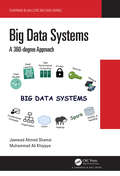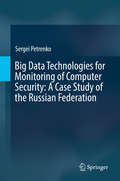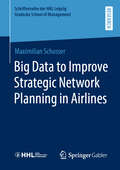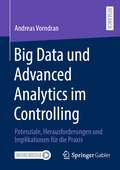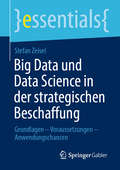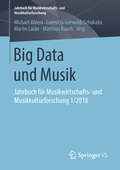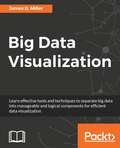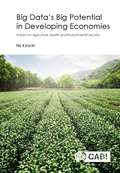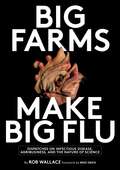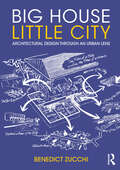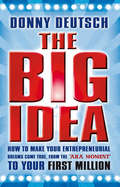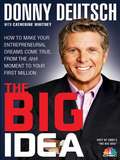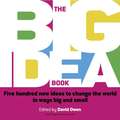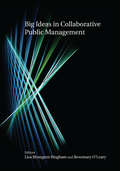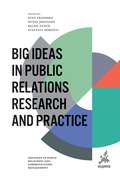- Table View
- List View
Big Data Systems: A 360-degree Approach
by Jawwad Ahmad ShamsiBig Data Systems encompass massive challenges related to data diversity, storage mechanisms, and requirements of massive computational power. Further, capabilities of big data systems also vary with respect to type of problems. For instance, distributed memory systems are not recommended for iterative algorithms. Similarly, variations in big data systems also exist related to consistency and fault tolerance. The purpose of this book is to provide a detailed explanation of big data systems. The book covers various topics including Networking, Security, Privacy, Storage, Computation, Cloud Computing, NoSQL and NewSQL systems, High Performance Computing, and Deep Learning. An illustrative and practical approach has been adopted in which theoretical topics have been aided by well-explained programming and illustrative examples. Key Features: Introduces concepts and evolution of Big Data technology. Illustrates examples for thorough understanding. Contains programming examples for hands on development. Explains a variety of topics including NoSQL Systems, NewSQL systems, Security, Privacy, Networking, Cloud, High Performance Computing, and Deep Learning. Exemplifies widely used big data technologies such as Hadoop and Spark. Includes discussion on case studies and open issues. Provides end of chapter questions for enhanced learning.
Big Data Technologies for Monitoring of Computer Security: A Case Study of the Russian Federation
by Sergei PetrenkoThis timely book offers rare insight into the field of cybersecurity in Russia -- a significant player with regard to cyber-attacks and cyber war. Big Data Technologies for Monitoring of Computer Security presents possible solutions to the relatively new scientific/technical problem of developing an early-warning cybersecurity system for critically important governmental information assets. Using the work being done in Russia on new information security systems as a case study, the book shares valuable insights gained during the process of designing and constructing open segment prototypes of this system. Most books on cybersecurity focus solely on the technical aspects. But Big Data Technologies for Monitoring of Computer Security demonstrates that military and political considerations should be included as well. With a broad market including architects and research engineers in the field of information security, as well as managers of corporate and state structures, including Chief Information Officers of domestic automation services (CIO) and chief information security officers (CISO), this book can also be used as a case study in university courses.
Big Data to Improve Strategic Network Planning in Airlines (Schriftenreihe der HHL Leipzig Graduate School of Management)
by Maximilian SchosserBig data has become an important success driver in airline network planning. Maximilian Schosser explores the status quo of network planning across a case study group consisting of nine airlines representing different business models. The author describes 23 big data opportunities for airline network planning and evaluates them based on their specific value contribution for airline network planning. Subsequently, he develops a financial evaluation methodology for big data opportunities based on key performance indicators for airline network planning departments.
Big Data und Advanced Analytics im Controlling: Potenziale, Herausforderungen und Implikationen für die Praxis
by Andreas VorndranDie Digitalisierung und Entwicklungen im Gebiet der künstlichen Intelligenz haben in den letzten Jahren erhebliche Veränderungen in der Gesellschaft und der Unternehmenspraxis hervorgerufen. Aufkommende Technologien in den Feldern Big Data und Advanced Analytics werden auch im Controlling zunehmend diskutiert oder bereits eingesetzt. Dabei befinden sich der Wissensstand, inwieweit Big Data und Advanced Analytics das Controlling beeinflussen und verändern können, und die praktische Anwendung noch in einem frühen Stadium. Diese Arbeit befasst sich deshalb mit der Untersuchung der möglichen Auswirkungen von Big Data und Advanced Analytics im Controlling. Vor diesem Hintergrund werden die Einflüsse dieser digitalen Trends auf den Informationsversorgungsprozess des Controllings, auf die Erfüllung Controlling-spezifischer Anforderungen an Informationen und auf das Forecasting, die Budgetierung und die strategische Planung analysiert. Ferner werden praxisrelevante Herausforderungen, Grenzen und Risiken bei der Implementierung und Nutzung identifiziert sowie Implikationen zu deren Umgang zur Ausschöpfung der Potenziale abgeleitet.
Big Data und allgemein zugängliche Daten im Krisenmanagement: Exemplarische technische und normative Gestaltung von Analysen zur Entscheidungsunterstützung (DuD-Fachbeiträge)
by Bernd Uwe DesoiBernd Uwe Desoi beleuchtet die Risiken und Chancen des Einsatzes von Big-Data-Analysen vornehmlich durch die öffentliche Verwaltung. Schwerpunkt der Arbeit ist eine exemplarische rechtliche Betrachtung der Analyse allgemein zugänglicher Daten im Internet in Form von Microblogs, die über das Datenschutzgrundrecht der informationellen Selbstbestimmung hinausgeht. Basierend auf den grundrechtlichen Rahmenbedingungen erarbeitet der Autor technisch-organisatorische Gestaltungsvorschläge und normative Vorschläge, die einen rechtsgemäßen Einsatz eines konkreten Analysesystems aufzeigen.
Big Data und Data Science in der strategischen Beschaffung: Grundlagen – Voraussetzungen – Anwendungschancen (essentials)
by Stefan ZeiselBig Data und Data Science sind Trends, die sowohl in der Wissenschaft als auch in Unternehmen auf großes Interesse stoßen. Dieses essential zeigt einen konzeptionellen Rahmen auf, um die Grundlagen von Big Data und Data Science besser zu verstehen. Einkaufsentscheider und Einkaufsorganisationen können dann aufbauend auf der Beschaffungsdigitalisierung sowie weiteren Datenquellen ein Big Data Warehouse konzipieren, welches die Voraussetzung schafft, um wichtige Beschaffungsprobleme zu lösen. Analytische Methoden werden genauso beleuchtet, wie neue Fähigkeiten in bereichsübergreifenden Teams. Abschließend werden 30 konkrete Anwendungsfälle von Big Data für die strategische Beschaffung vorgestellt.
Big Data und Musik: Jahrbuch für Musikwirtschafts- und Musikkulturforschung 1/2018 (Jahrbuch für Musikwirtschafts- und Musikkulturforschung)
by Michael Ahlers Lorenz Grünewald-Schukalla Martin Lücke Matthias RauchBig Data ist nicht nur Sache von Versicherungen und Internetunternehmen. Auch für die global agierende Musikwirtschaft, die in den letzten knapp 20 Jahren bereits zahlreiche Transformationen überstehen musste, werden Sammlung, Analyse und Verwertung großer Datenmengen zu einem immer zentraleren Thema. Das aktuelle Jahrbuch der Gesellschaft für Musikwirtschafts- und Musikkulturforschung versammelt hierzu unterschiedliche Ansätze und Perspektiven auf das Thema Big Data und Musik: Von den Datafication-Algorithmen Spotifys über die rechtlichen Implikationen von Music Data Mining, die Blockchain oder der Nutzung von Big Data im Artist & Repertoire Management werden zentrale Anwendungsfelder von Musik und Big Data in den Blick genommen.
Big Data Visualization
by James D. Miller 2 28 2017Learn effective tools and techniques to separate big data into manageable and logical components for efficient data visualizationAbout This BookThis unique guide teaches you how to visualize your cluttered, huge amounts of big data with easeIt is rich with ample options and solid use cases for big data visualization, and is a must-have book for your shelfImprove your decision-making by visualizing your big data the right wayWho This Book Is ForThis book is for data analysts or those with a basic knowledge of big data analysis who want to learn big data visualization in order to make their analysis more useful. You need sufficient knowledge of big data platform tools such as Hadoop and also some experience with programming languages such as R. This book will be great for those who are familiar with conventional data visualizations and now want to widen their horizon by exploring big data visualizations.What You Will LearnUnderstand how basic analytics is affected by big dataDeep dive into effective and efficient ways of visualizing big dataGet to know various approaches (using various technologies) to address the challenges of visualizing big dataComprehend the concepts and models used to visualize big dataKnow how to visualize big data in real time and for different use casesUnderstand how to integrate popular dashboard visualization tools such as Splunk and TableauGet to know the value and process of integrating visual big data with BI tools such as TableauMake sense of the visualization options for big data, based upon the best suited visualization techniques for big dataIn DetailWhen it comes to big data, regular data visualization tools with basic features become insufficient. This book covers the concepts and models used to visualize big data, with a focus on efficient visualizations.This book works around big data visualizations and the challenges around visualizing big data and address characteristic challenges of visualizing like speed in accessing, understanding/adding context to, improving the quality of the data, displaying results, outliers, and so on. We focus on the most popular libraries to execute the tasks of big data visualization and explore "big data oriented" tools such as Hadoop and Tableau. We will show you how data changes with different variables and for different use cases with step-through topics such as: importing data to something like Hadoop, basic analytics.The choice of visualizations depends on the most suited techniques for big data, and we will show you the various options for big data visualizations based upon industry-proven techniques. You will then learn how to integrate popular visualization tools with graphing databases to see how huge amounts of certain data. Finally, you will find out how to display the integration of visual big data with BI using Cognos BI.Style and approachWith the help of insightful real-world use cases, we'll tackle data in the world of big data. The scalability and hugeness of the data makes big data visualizations different from normal data visualizations, and this book addresses all the difficulties encountered by professionals while visualizing their big data.
Big Data’s Big Potential in Developing Economies: Impact on Agriculture, Health and Environmental Security
by Nir KshetriBig data involves the use of sophisticated analytics to make decisions based on large-scale data inputs. It is set to transform agriculture, environmental protection and healthcare in developing countries. This book critically evaluates the developing big data industry and market in these countries and gives an overview of the determinants, performance and impacts. It provides a detailed analysis of technology creation, technology infrastructures and human skills required to utilize big data while discussing novel applications and business models that make use of it to overcome healthcare barriers. The book also offers an analysis of big data's potential to improve environmental monitoring and protection where it is likely to have far-reaching and profound impacts on the agricultural sector. A key question addressed is how gains in agricultural productivity associated with big data will benefit smallholder farmers relative to global multinationals in that sector. The book also probes big data's roles in the creation of markets that can improve the welfare of smallholder farmers. Special consideration is given to big data-led transformation of the financial industry and discusses how the transformation can increase small-holder farmers' access to finance by changing the way lenders assess creditworthiness of potential borrowers. It also takes a look at data privacy and security issues facing smallholder farmers and reviews differences in such issues in industrialized and developing countries. The key ideas, concepts and theories presented are explored, illustrated and contrasted through in-depth case studies of developing world-based big data companies, and deployment and utilization of big data in agriculture, environmental protection and healthcare.
The Big Ditch: How America Took, Built, Ran, and Ultimately Gave Away the Panama Canal
by Noel Maurer Carlos YuOn August 15, 1914, the Panama Canal officially opened for business, forever changing the face of global trade and military power, as well as the role of the United States on the world stage. The Canal's creation is often seen as an example of U.S. triumphalism, but Noel Maurer and Carlos Yu reveal a more complex story. Examining the Canal's influence on Panama, the United States, and the world, The Big Ditch deftly chronicles the economic and political history of the Canal, from Spain's earliest proposals in 1529 through the final handover of the Canal to Panama on December 31, 1999, to the present day. The authors show that the Canal produced great economic dividends for the first quarter-century following its opening, despite massive cost overruns and delays. Relying on geographical advantage and military might, the United States captured most of these benefits. By the 1970s, however, when the Carter administration negotiated the eventual turnover of the Canal back to Panama, the strategic and economic value of the Canal had disappeared. And yet, contrary to skeptics who believed it was impossible for a fledgling nation plagued by corruption to manage the Canal, when the Panamanians finally had control, they switched the Canal from a public utility to a for-profit corporation, ultimately running it better than their northern patrons. A remarkable tale, The Big Ditch offers vital lessons about the impact of large-scale infrastructure projects, American overseas interventions on institutional development, and the ability of governments to run companies effectively.
The Big Ditch: How America Took, Built, Ran, and Ultimately Gave Away the Panama Canal
by Noel Maurer Carlos YuOn August 15, 1914, the Panama Canal officially opened for business, forever changing the face of global trade and military power, as well as the role of the United States on the world stage. The Canal's creation is often seen as an example of U.S. triumphalism, but Noel Maurer and Carlos Yu reveal a more complex story. Examining the Canal's influence on Panama, the United States, and the world, The Big Ditch deftly chronicles the economic and political history of the Canal, from Spain's earliest proposals in 1529 through the final handover of the Canal to Panama on December 31, 1999, to the present day. The authors show that the Canal produced great economic dividends for the first quarter-century following its opening, despite massive cost overruns and delays. Relying on geographical advantage and military might, the United States captured most of these benefits. By the 1970s, however, when the Carter administration negotiated the eventual turnover of the Canal back to Panama, the strategic and economic value of the Canal had disappeared. And yet, contrary to skeptics who believed it was impossible for a fledgling nation plagued by corruption to manage the Canal, when the Panamanians finally had control, they switched the Canal from a public utility to a for-profit corporation, ultimately running it better than their northern patrons. A remarkable tale, The Big Ditch offers vital lessons about the impact of large-scale infrastructure projects, American overseas interventions on institutional development, and the ability of governments to run companies effectively.
The Big Fail: How Our Supply Chains Collapsed When We Needed Them Most
by Bethany McLean Joe NoceraFrom the author of the modern business classic The Smartest Guys in the Room comes a damning indictment of late-stage capitalism-and the leaders that were brutally unprepared for a global pandemic.In 2020, the coronavirus pandemic made it painfully clear that governments across the world could not adequately protect their citizens. Millions of people suffered and died in just two years, while administrations around the globe blundered; prize-winning economists overlooked devastating trade-offs from the collapse of trade; and elites escaped to isolated retreats, unaffected by - and worse, even profiting from - the worst healthcare crisis to hit humanity in decades.In this page-turning economic, political and financial history, veteran journalists Bethany McClean and Joseph Nocera analyse the American response to the pandemic as a case study, to offer fresh and provocative answers. With laser-sharp reporting and deep sourcing, they investigate what really happened when governments ran out of PPE due to snarled supply chains; and the shock to the financial system when the world's biggest economies stumbled. They zero in on the effectiveness of wildly polarised approaches across states, and they trace why thousands died in hollowed-out hospital systems and nursing homes run by private equity firms, all in the name of "maximising shareholder value".The Big Fail is an expansive, gripping narrative account on what the pandemic did to one economy, and how it forced us to question the fundamental principles of our society
Big Farms Make Big Flu: Dispatches On Influenza, Agribusiness, And The Nature Of Science
by Rob WallaceThanks to breakthroughs in production and food science, agribusiness has been able to devise new ways to grow more food and get it more places more quickly. There is no shortage of news items on hundreds of thousands of hybrid poultry—each animal genetically identical to the next—packed together in megabarns, grown out in a matter of months, then slaughtered, processed and shipped to the other side of the globe. Less well known are the deadly pathogens mutating in, and emerging out of, these specialized agro-environments. In fact, many of the most dangerous new diseases in humans can be traced back to such food systems, among them Campylobacter, Nipah virus, Q fever, hepatitis E, and a variety of novel influenza variants. Agribusiness has known for decades that packing thousands of birds or livestock together results in a monoculture that selects for such disease. But market economics doesn't punish the companies for growing Big Flu—it punishes animals, the environment, consumers, and contract farmers. Alongside growing profits, diseases are permitted to emerge, evolve, and spread with little check. “That is,” writes evolutionary biologist Rob Wallace, “it pays to produce a pathogen that could kill a billion people.” In Big Farms Make Big Flu, a collection of dispatches by turns harrowing and thought-provoking, Wallace tracks the ways influenza and other pathogens emerge from an agriculture controlled by multinational corporations. Wallace details, with a precise and radical wit, the latest in the science of agricultural epidemiology, while at the same time juxtaposing ghastly phenomena such as attempts at producing featherless chickens, microbial time travel, and neoliberal Ebola. Wallace also offers sensible alternatives to lethal agribusiness. Some, such as farming cooperatives, integrated pathogen management, and mixed crop-livestock systems, are already in practice off the agribusiness grid. While many books cover facets of food or outbreaks, Wallace's collection appears the first to explore infectious disease, agriculture, economics and the nature of science together. Big Farms Make Big Flu integrates the political economies of disease and science to derive a new understanding of the evolution of infections. Highly capitalized agriculture may be farming pathogens as much as chickens or corn.
Big Fellow, Long Fellow. A Joint Biography of Collins and De Valera: A Joint Biography of Irish politicians Michael Collins and Eamon De Valera
by Dr T. Ryle DwyerMichael Collins and Eamon de Valera were the two most charismatic leaders of the Irish revolution. This joint biography looks first at their very different upbringings and early careers. Both fought in the 1916 Easter Rising , although it is almost certain they did not meet during that tumultuous week. Their first encounter came when Collins had been released from jail after the rising but de Valera was still inside. Collins was one of those who wanted to run a Sinn Féin candidate in the Longford by-election of 1917. De Valera and other leaders opposed this initiative but the Collins group went ahead anyway and the candidate won narrowly. The incident typified the relationship between the two men: they were vastly different in temperament and style. But it was precisely in their differences and contradictions that their fascination lay. De Valera, the political pragmatist, hoped to secure independence through political agitation, whereas the ambitious Collins, with his restless temperament and boundless energy, was an impassioned patriot who believed in terror and assassination. T. Ryle Dwyer examines the years, 1917-22 through the twists and turns of their careers. In an epilogue, he considers the legacy of Collins on de Valera's political life.
The Big Four and the Development of the Accounting Profession in China (Studies in the Development of Accounting Thought #16)
by Paul GillisDrawing upon established academic theory, the study argues that the Big Four, as part of a globalizing transnational capital class, has dominated indigenous firms by bringing to China an ideology that came to be accepted as normative. By winning this battle of ideology, the Big Four gained access to the coercive power of the State, and to the power of transnational institutions that have subsumed part of the power of the State. Indigenous firms have pursued a counter-hegemonic strategy of undermining the ideological superiority of the Big Four through the infiltration and modification of institutional arrangements following what the academic literature calls "the long march through the institutions.
The Big Four British Banks: Organisation, Strategy and the Future
by David RogersThis book is a cutting-edge exploration of the UK commercial banking industry, as reflected primarily in the experience of the four main clearing banks: Barclays, Lloyds, Midland and NatWest. What will the industry look like in the future? What strategies, cultures and organisational forms will distinguish the survivors from the non-survivors? Will the dominant form be the highly diversified, global, financial supermarket, the so-called universal bank, the more focused niche player, both, or some other type? To answer these questions, David Rogers draws upon very high level access to the leading players in this evolving industry.
Big House Little City: Architectural Design Through an Urban Lens
by Benedict ZucchiCombining architectural and urban thinking in an unusual and engaging way, this book presents an integrated approach to architectural theory and design. Leon Battista Alberti’s assertion in his famous Renaissance treatise that ‘the city is like a big house, and the house is in turn like a little city’ forms the springboard for a series of reflections on architecture’s relationship with urbanism and how their once intimate symbiosis, unravelled by International Style Modernism, can be recovered. Explicit references to Alberti’s house-city phrase have been made by figures as diverse as the architects Louis Kahn, Aldo Van Eyck, Denys Lasdun and Niels Torp and novelist Italo Calvino. But, as the book shows, thinking of buildings as little cities provides a new lens through which to reappraise the contributions of many other architects, including Le Corbusier, Frank Lloyd Wright, Alvar Aalto, Eliel Saarinen, Bernard Rudofsky, Hans Scharoun, Leon Krier, Fumihiko Maki, Charles Correa and Team 10. In doing so, the author identifies common themes that form an unexpected bridgehead between the urban and architectural approaches of Antiquity, the Middle Ages, Renaissance and 20th century. The book explores buildings from across the globe, including lesser-known projects, such as Wright’s unbuilt house in Italy or Saarinen’s master plan for Cranbrook Academy, as well as more recent projects by Niels Torp, Behnisch Architekten, Sou Fujimoto, Peter Barber and WOHA. It concludes with practical case studies of residential, health, education and workplace projects from different countries, fulsomely illustrated with many drawings and photographs. These show how architectural design viewed through an urban lens provides a conceptual framework for breaking down the scale of large buildings and integrating them with their context. And crucially, these also show a very accessible way of explaining evolving designs to the intended users and eliciting their participation in the design process. The book offers a compelling approach to the design of projects at all scales, within an ecological perspective: the sense that big and small, cities and buildings must be approached holistically if we are to reverse the degradation and depletion of our habitat, both natural and man-made.
Big House Little City: Architectural Design Through an Urban Lens
by Benedict ZucchiCombining architectural and urban thinking in an unusual and engaging way, this book presents an integrated approach to architectural theory and design. Leon Battista Alberti’s assertion in his famous Renaissance treatise that ‘the city is like a big house, and the house is in turn like a little city’ forms the springboard for a series of reflections on architecture’s relationship with urbanism and how their once intimate symbiosis, unravelled by International Style Modernism, can be recovered. Explicit references to Alberti’s house-city phrase have been made by figures as diverse as the architects Louis Kahn, Aldo Van Eyck, Denys Lasdun and Niels Torp and novelist Italo Calvino. But, as the book shows, thinking of buildings as little cities provides a new lens through which to reappraise the contributions of many other architects, including Le Corbusier, Frank Lloyd Wright, Alvar Aalto, Eliel Saarinen, Bernard Rudofsky, Hans Scharoun, Leon Krier, Fumihiko Maki, Charles Correa and Team 10. In doing so, the author identifies common themes that form an unexpected bridgehead between the urban and architectural approaches of Antiquity, the Middle Ages, Renaissance and 20th century. The book explores buildings from across the globe, including lesser-known projects, such as Wright’s unbuilt house in Italy or Saarinen’s master plan for Cranbrook Academy, as well as more recent projects by Niels Torp, Behnisch Architekten, Sou Fujimoto, Peter Barber and WOHA. It concludes with practical case studies of residential, health, education and workplace projects from different countries, fulsomely illustrated with many drawings and photographs. These show how architectural design viewed through an urban lens provides a conceptual framework for breaking down the scale of large buildings and integrating them with their context. And crucially, these also show a very accessible way of explaining evolving designs to the intended users and eliciting their participation in the design process. The book offers a compelling approach to the design of projects at all scales, within an ecological perspective: the sense that big and small, cities and buildings must be approached holistically if we are to reverse the degradation and depletion of our habitat, both natural and man-made.
The Big Idea: How To Make Your Entrepreneurial Dreams Come True, From The Aha Moment To Your First Million
by Donny DeutschBased on the award-winning formula of his hugely popular nightly show on CNBC, Donny Deutsch's The Big Idea is a step-by-step guide for anyone who has ever dreamt of following through on creating their own business. From the 'Aha! Moment' to taking that all-important first leap, Deutsch cheers aspiring entrepreneurs along every step of the way. Starting with how to look for opportunities, through to keeping what you've created going and growing, each stage of the process is illustrated by an invaluable lesson learned by a leading entrepreneur. With the author's irrepressible energy, enthusiasm and expertise providing the engine that drives this incredibly upbeat book, The Big Idea will provide the tools to tackle issues head on, and is the ideal how-to for entrepreneurs - from inventors to artists, marketers to producers, teenagers to retirees.
The Big Idea: How to Make Your Entrepreneurial Dreams Come True, from the Aha Moment to Your First Million
by Donny DeutschIt's the moment when you say, "There's gotta be a better way." It's the moment when you ask, "How can I solve this problem?" Donny Deutsch's hit CNBC show The Big Idea has put the spotlight on that ordinary moment and the people who have the courage and stamina to make their dreams come true. Some people think a big idea is like a lightning bolt striking out of the blue that slams you in the head. But it's hardly ever like that. The big idea isn't an act of God. It's an act of daily life. Simply put, the idea that will make millions starts with an observation. A carpenter gets tired of almost losing a finger every time he slices a bagel. Bam! The Bagel Guillotine. A mother is frustrated that her pantry is full of stale food because the packages don't close. Bam! Quick Seals. Howard Schultz notices on a trip to Italy that there are coffee bars on almost every corner. Bam! Starbucks. None of them had a barrel of cash. None of them had a ton of experience. They had a big idea and the will to follow through. In The Big Idea, Deutsch draws not only on his own tremendous focus and expertise, but on that of dozens of the successful entrepreneurs whom he has interviewed, to help you create your own enterprise. From the "Gut Check Moment" to "Mom Power," The Big Idea takes aspiring entrepreneurs along every step of the way. The Big Idea is your road map to the American dream.
The Big Idea Book: Five hundred new ideas to change the world in ways big and small
by David OwenIdeas are like buses, you wait forever and then 500 come along at once. The Big Idea Book is 500 novel, ingenious and downright crazy ideas designed to inspire, amuse and divert. Developed by the team behind the innovative website, Idea-a-Day at www.idea-a-day.com, it covers everything from business to travel, politics to money and everything in between. Idea-a-Day has a vast network of followers and contributors - some famous, some infamous, some revered, some reviled – who post ideas to be read, enjoyed, used or abused. Seth Godin, Malcolm Maclaren and Wayne Hemmingway are just a few of its fans. In The Big Idea Book all this creative energy is mixed together with unpublished ideas, quotes, cartoons, illustrations and thought-pieces to give creatives and cool office types a visual and intellectual treat guaranteed to kickstart the imagination and creative flair!
Big Ideas in Collaborative Public Management
by Lisa Blomgren Bingham Rosemary O'LearyThe world of public management is changing dramatically, fueled by technological innovations such as the Internet, globalism that permits us to outsource functions anywhere in the world, new ideas from network theory, and more. Public managers no longer are unitary leaders of unitary organizations - instead, they often find themselves convening, negotiating, mediating, and collaborating across borders."Big Ideas in Collaborative Public Management" brings together a rich variety of big picture perspectives on collaborative public management. The chapters are all original and written by distinguished experts. Designed for practical application, they range from examinations of under what conditions collaborative public management occurs to what it means to be a collaborative leader.The contributors address tough issues such as legitimacy building in networks, and discuss ways to engage citizens in collaboration. They examine the design of collaborative networks and the outcomes of collaboration. Detailed introductory and concluding chapters by the editors summarize and critique the chapters, and frame them as a reflection of the state of collaborative public management today.
Big Ideas in Collaborative Public Management
by Lisa Blomgren Bingham Rosemary O'LearyThe world of public management is changing dramatically, fueled by technological innovations such as the Internet, globalism that permits us to outsource functions anywhere in the world, new ideas from network theory, and more. Public managers no longer are unitary leaders of unitary organizations - instead, they often find themselves convening, negotiating, mediating, and collaborating across borders."Big Ideas in Collaborative Public Management" brings together a rich variety of big picture perspectives on collaborative public management. The chapters are all original and written by distinguished experts. Designed for practical application, they range from examinations of under what conditions collaborative public management occurs to what it means to be a collaborative leader.The contributors address tough issues such as legitimacy building in networks, and discuss ways to engage citizens in collaboration. They examine the design of collaborative networks and the outcomes of collaboration. Detailed introductory and concluding chapters by the editors summarize and critique the chapters, and frame them as a reflection of the state of collaborative public management today.
Big Ideas in Public Relations Research and Practice (Advances in Public Relations and Communication Management #4)
by Finn Frandsen Winni Johansen Ralph Tench Stefania RomentiBig Ideas can do many things. They are transformative and change the way we work and communicate in organizations and societies. As Big Ideas are dynamic, they can cross borders between disciplines to create new relationships between people, organizations and countries. In applying big ideas to public relations, this volume challenges how scholars and practitioners perceive and understand public relations within an organizational setting. In thinking about the 'bigger picture', the collection expands public relations research to include more theory-building, more cross-disciplinary research, and more innovation in practice. The 12 unique contributions from scholars based in Germany, Denmark, The Netherlands, France, Romania, the UK, Finland, Portugal and the USA explore the challenges surrounding communication, management and big ideas. Some of the topics discussed include: corporate identity, millennial engagement, strategic communication in the internationalization of firms, public relations in the start-up community and, social capital.
Big Ideas in Public Relations Research and Practice: Strategic Opportunities, Innovation And Critical Challenges (Advances in Public Relations and Communication Management #4)
by Finn Frandsen Winni Johansen Ralph Tench Stefania RomentiBig Ideas can do many things. They are transformative and change the way we work and communicate in organizations and societies. As Big Ideas are dynamic, they can cross borders between disciplines to create new relationships between people, organizations and countries. In applying big ideas to public relations, this volume challenges how scholars and practitioners perceive and understand public relations within an organizational setting. In thinking about the 'bigger picture', the collection expands public relations research to include more theory-building, more cross-disciplinary research, and more innovation in practice. The 12 unique contributions from scholars based in Germany, Denmark, The Netherlands, France, Romania, the UK, Finland, Portugal and the USA explore the challenges surrounding communication, management and big ideas. Some of the topics discussed include: corporate identity, millennial engagement, strategic communication in the internationalization of firms, public relations in the start-up community and, social capital.
